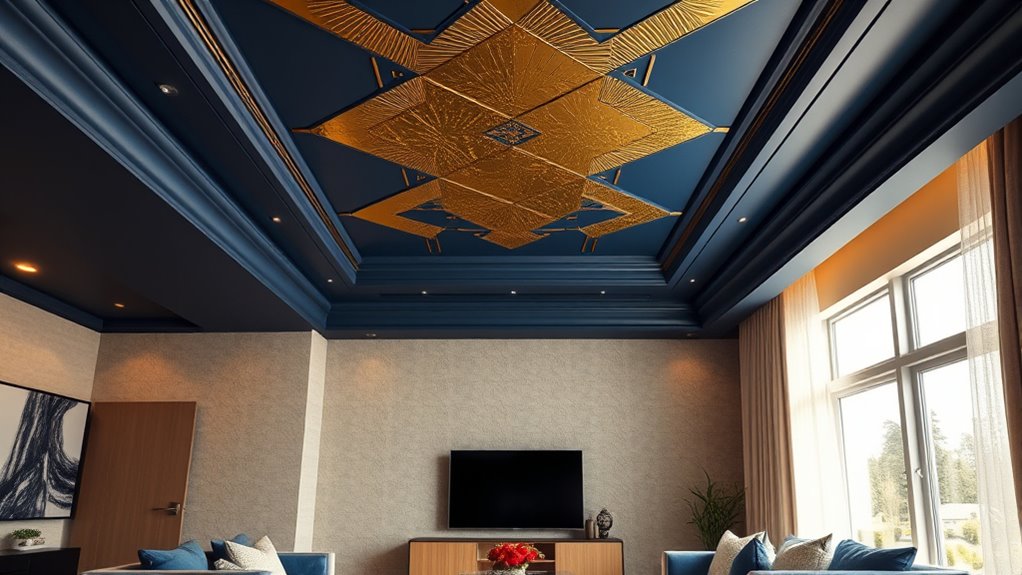Adding a personality above is easy with a DIY accent ceiling. Start by choosing a bold paint color or adding decorative molding to create visual interest. Make sure your surface is smooth and clean before applying paint, and use painter’s tape to keep edges neat. Measuring and fitting molding precisely will give your ceiling a polished look. Keep experimenting with color and texture, and you’ll uncover simple ways to elevate your space—more tips await as you go further.
Key Takeaways
- Choose bold ceiling paint colors like navy or emerald to create a striking focal point.
- Incorporate decorative molding to add texture and visual interest above.
- Properly prep surfaces and tape edges for a smooth, professional-looking finish.
- Measure and cut molding precisely to ensure a perfect fit and clean lines.
- Test paint samples beforehand to select the best color that complements your decor.

Adding an accent ceiling is an easy way to transform a room and showcase your personal style. It draws the eye upward, creating a striking focal point that can completely change the vibe of any space. When you’re considering how to do this yourself, one of the simplest and most effective techniques is to use ceiling paint. Choosing the right color can make the ceiling feel higher, cozier, more energetic, or more calming—depending on your mood and design goals. For a bold look, opt for a deep, rich hue like navy or emerald, and for a more subtle effect, a soft pastel or neutral shade can add just enough interest without overwhelming the room. Applying ceiling paint requires careful preparation: ensure the surface is clean and smooth, tape off the walls and fixtures, and use a high-quality roller or brush for even coverage. With patience and a steady hand, you can achieve a professional-looking finish that instantly elevates your space.
Incorporating decorative molding is another fantastic way to add personality and dimension to your accent ceiling. Moldings can frame the painted area or be used as accents themselves, creating visual interest and depth. You might choose crown molding with ornate details for a classic look or opt for simple, clean lines for a modern aesthetic. Installing decorative molding is straightforward, especially if you have basic carpentry skills. Measure carefully, cut the pieces precisely, and use nails or adhesive to secure them in place. Once installed, you can paint the molding the same or a contrasting color to highlight its details or keep it neutral for a more understated effect. Combining decorative molding with a bold ceiling paint can result in a sophisticated, layered look that reflects your personality and taste.
The key to a successful DIY accent ceiling is planning and patience. Think about how the colors and moldings will complement your existing decor. Take your time prepping the surface, taping edges neatly, and applying paint smoothly. If you’re unsure about color choices, test samples on a small section of the ceiling first. When it comes to molding, don’t rush the measurement and cutting—precision makes a big difference. Additionally, understanding paint application techniques can help you achieve a flawless finish. With some effort, you can create a stunning feature that adds character and charm to your room, all while expressing your unique style. Whether you’re going for a subtle detail or a dramatic statement, accent ceilings are a perfect way to make your space truly your own.
Frequently Asked Questions
Can Accent Ceilings Be Installed in Bathrooms or Humid Areas?
Yes, you can install accent ceilings in bathrooms or humid areas if you use moisture-resistant materials like PVC, water-resistant paint, or specialized tiles. Make sure to contemplate proper ventilation to prevent mold and moisture buildup. Adequate airflow helps maintain your accent ceiling’s appearance and longevity. By combining these materials and ventilation considerations, you create a stylish, durable feature that enhances your bathroom’s personality without sacrificing practicality.
What Are the Best Lighting Options for Accent Ceilings?
Imagine you’re transforming your living room with a stunning accent ceiling. The best lighting options include ambient lighting, like recessed LEDs, to create a soft glow, and statement fixtures such as chandelier pendants or modern track lighting that draw attention upward. These choices enhance the ceiling’s personality, add warmth, and set the mood, making your space feel inviting and stylish. Choose fixtures that complement your decor and provide the perfect balance of light.
How Do I Choose the Right Color for My Accent Ceiling?
You choose the right color for your accent ceiling by considering color harmony and visual contrast. Pick a hue that complements your room’s existing palette for a harmonious look, or select a bold, contrasting color to make the ceiling stand out. Think about the mood you want to create—calm or energetic—and test paint samples in different lighting to see how they change throughout the day.
Are There Eco-Friendly Materials Suitable for DIY Accent Ceilings?
Yes, you can choose eco-friendly materials for your DIY accent ceiling. Look for recyclable materials like reclaimed wood or metal, which reduce waste and environmental impact. Natural finishes such as beeswax or plant-based sealants are great options to enhance the look while staying sustainable. These choices not only add personality to your space but also support eco-conscious living, making your project both stylish and environmentally responsible.
How Long Does a Typical DIY Accent Ceiling Project Take?
A typical DIY accent ceiling project takes about one to three days, depending on your design complexity and preparation. You should consider timing considerations like drying times for paint or adhesives, and plan your project accordingly. Proper project planning helps you allocate enough time for each step, from surface prep to finishing touches, ensuring a smooth process without rushing. Remember, patience leads to a polished, personalized ceiling.
Conclusion
Thinking about adding an accent ceiling? It’s more than just a design trend—it’s a way to truly personalize your space and make it feel uniquely yours. Some say the ceiling’s just the “fifth wall,” but in reality, it’s your chance to express creativity and break the mold. When you take on this DIY project, you’re not just decorating—you’re transforming your home into a reflection of your personality. So go ahead, elevate your space and let your ceiling speak volumes.








